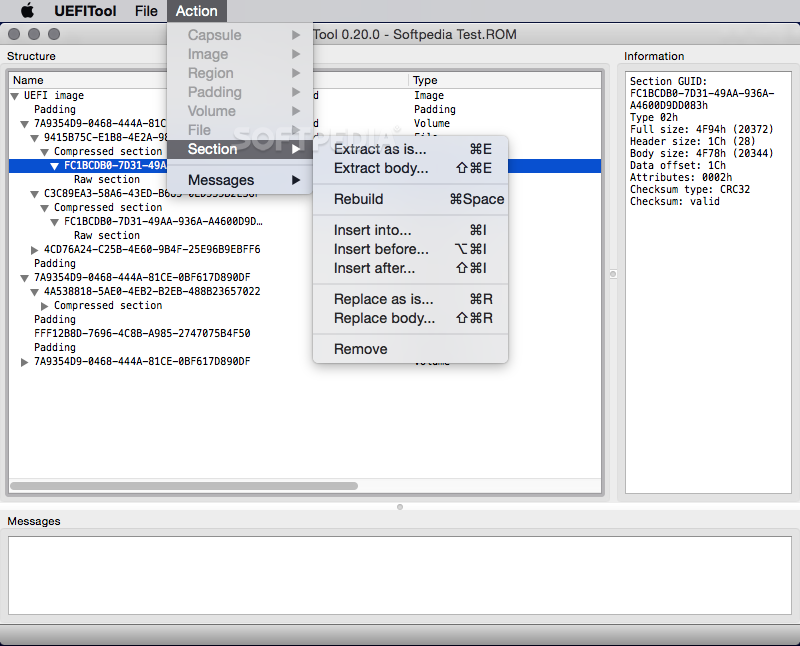
- #UEFITOOL ADD UEFI SHELL TO BIOS HOW TO#
- #UEFITOOL ADD UEFI SHELL TO BIOS FULL#
- #UEFITOOL ADD UEFI SHELL TO BIOS CODE#
To boot from a bootable USB device, place the USB device before the hard drive in the boot sequence. To boot from bootable OS or diagnostic CDs or DVDs, place the CD or DVD (optical) drive before the hard drive in the boot sequence. Hard drive, optical (CD/DVD, Blu-ray), USB, network ROM order as wanted However, many laptops with UEFI firmware use a text-based interface similar to BIOS. Most desktop systems with UEFI firmware use a mouse-driven graphical interface. UEFI firmware offers similar settings to those used by a traditional BIOS (see Figure 2-2) along with additional options (refer to Figures 2-3 and beyond).

Larger-size ROM chips used by UEFI make room for additional features, better diagnostics, the ability to open a shell environment for easy flash updates, and the ability to save multiple BIOS configurations for reuse.
#UEFITOOL ADD UEFI SHELL TO BIOS FULL#
These drives require the use of the GUID Partition Table (GPT) to access full capacity.įaster system startup (booting) and other optimizations. Support for hard drives of 2.2TB and higher capacity. Compared to a traditional Flash ROM BIOS, UEFI has the following advantages: Most recent desktop and laptop computers (and all desktop and laptop computers from 2014 on) now use a new type of firmware called the Unified Extensible Firmware Initiative (UEFI) to display a mouse-driven GUI or text-based menu for BIOS setup. Just press the key or key combination displayed onscreen (or described in the manual) to get started. The BIOS configuration program is stored in the BIOS chip itself. Originally, the BIOS setup program was run from a bootable floppy disk, but for many years virtually all system BIOS chips have included the setup program. To perform this task, the system assembler must use the BIOS setup program to make changes and save them to the CMOS (complementary metal oxide semiconductor) chip. The system BIOS has default settings provided by the system or motherboard maker, but as a system is built up with storage devices, memory modules, adapter cards, and other components, it is usually necessary to alter the standard settings. Foundation Topics BIOS/UEFI Configuration
#UEFITOOL ADD UEFI SHELL TO BIOS HOW TO#
In this chapter, you find out about how the BIOS/UEFI, CMOS, and batteries on the motherboard interact and learn how to configure and upgrade the BIOS.įrom this point on, the term BIOS refers to both traditional BIOS and UEFI firmware except when they differ in function.Ģ20-901: Objective 1.1 Given a scenario, configure settings and use BIOS/UEFI tools on a PC. From this program, a user can change settings in the BIOS and upgrade the BIOS as well. The BIOS/UEFI resides on a ROM chip and stores a setup program that you can access when the computer first boots up.

If any errors occur, the BIOS/UEFI reports them as part of the testing stage, known as the power-on self-test (POST). It tests and initializes components such as the processor, RAM, video card, hard drives, optical, and USB drives. It prepares the machine by testing it during bootup and paves the way for the operating system to start.
#UEFITOOL ADD UEFI SHELL TO BIOS CODE#
This boot firmware, also known as System BIOS or, on most recent systems, unified extensible firmware interface (UEFI), is the first code run by a computer when it is booted. The Basic Input/Output System (BIOS) is an essential component of the motherboard.


Using BIOS/UEFI Diagnostics-In this section, you learn about diagnostic features built into many BIOS/UEFI chips. Introduction to BIOS/UEFI-This section explains the motherboard’s firmware, known as the BIOS or UEFI.īIOS/UEFI Configuration-This section demonstrates how to access the BIOS and modify settings for example, RAM, processor, and video settings.įlash Upgrade BIOS/UEFI-In this section, you learn how to upgrade the BIOS through a process known as flashing. This chapter covers the following subjects: CompTIA A+ 220-901 and 220-902 Cert Guide, 4th Edition


 0 kommentar(er)
0 kommentar(er)
